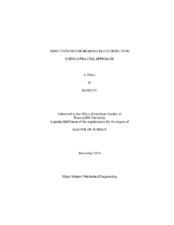| dc.contributor.advisor | Parlos, Alexander G | |
| dc.creator | Fu, Jianxi 1983- | |
| dc.date.accessioned | 2016-02-19T22:17:58Z | |
| dc.date.available | 2016-02-19T22:17:58Z | |
| dc.date.created | 2010-12 | |
| dc.date.issued | 2010-11-24 | |
| dc.date.submitted | December 2010 | |
| dc.identifier.uri | https://hdl.handle.net/1969.1/ETD-TAMU-2010-12-8812 | |
| dc.identifier.uri | https://hdl.handle.net/1969.1/156061 | |
| dc.description.abstract | Fault detection is an important research area in mechanical engineering. Literature
surveys indicate that bearing failures are considered the most common failure modes in
motors. Various faults related to bearings can be categorized into single-point defects or
generalized roughness defects. In many research studies, monitoring methods based on
vibration signals are used to detect single-point bearing failures. Depending on which
bearing surface contains the fault, the characteristic vibration frequencies can be
calculated from the rotor speed and the bearing geometry. It also has been demonstrated
that stator current monitoring can provide the same indication without requiring access
to the motor.
The combination of phase space reconstruction and fractal theory may provide an
effective approach to detect bearing generalized roughness faults in induction motors by
assembling the estimation of dynamic invariant properties of a nonlinear system. In
mathematics, a delay embedding theorem gives the conditions under which a chaotic
dynamical system can be reconstructed from a sequence of observations of the state of a
dynamical system by lagging the time series to embed it in more dimensions. One can determine the delay time by calculating mutual information with equality distant space
cells. False nearest neighbors provides a robust way to determine necessary embedding
dimensions. Almost all chaotic systems have a quantifying measurement known as a
fractal dimension which is extracted from the original or reconstructed phase space.
There are many specific forms of fractal dimension. In this research, correlation
dimension is used to estimate the dimension of attractors in nonlinear dynamical
systems.
Taking the result of Fourier based analysis as a reference for fault detection,
experimental results show that the proposed method is as effective in detecting bearing
generalized roughness faults in induction motors. | en |
| dc.format.mimetype | application/pdf | |
| dc.subject | Correlation dimension | en |
| dc.subject | Fractal | en |
| dc.subject | Phase space reconstruction | en |
| dc.subject | Sensorless condition monitoring | en |
| dc.subject | Bearing fault detection | en |
| dc.title | Induction Motor Bearing Fault Detection Using a Fractal Approach | en |
| dc.type | Thesis | en |
| thesis.degree.department | Mechanical Engineering | en |
| thesis.degree.discipline | Mechanical Engineering | en |
| thesis.degree.grantor | Texas A & M University | en |
| thesis.degree.name | Master of Science | en |
| thesis.degree.level | Masters | en |
| dc.contributor.committeeMember | Kim, Won-Jong | |
| dc.contributor.committeeMember | Rasmussen, Bryan | |
| dc.contributor.committeeMember | Silva-Martinez, Jose | |
| dc.type.material | text | en |
| dc.date.updated | 2016-02-19T22:17:59Z | |
| local.etdauthor.orcid | 0000-0003-3928-3047 | |


